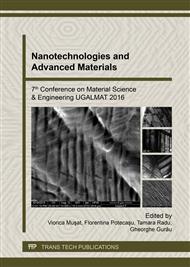p.85
p.91
p.97
p.103
p.108
p.114
p.120
p.127
p.133
Influence of Different Galvanic Sludge Types on the Extraction Efficiency of Chromium Ions
Abstract:
Galvanic sludge resulting from wastewater treatment is a hazardous waste that can be removed by disposal only after neutralization process. A chemically complex sludge is a mixture of hydroxides of the many heavy metals such us: copper, iron, nickel, chromium, cadmium and zinc. There is worldwide, a concern to develop methods and techniques for extraction and recovery of the metal compounds from sludge out of treatment processes of wastewater from metal plating works (washing wastewater and technological solutions) in order to reinsert them into existing industrial flows or to capitalize them in other industries, leading to a significant reduction of environmental pollution.This paper presents the results of the scientific activity in the laboratory with a view to recover Cr (VI, III) from two types of galvanic sludge: a fresh sludge from wastewaters treatment by Lancy technique and an old sludge, stabilized by disposal for many years. Chromium extraction was performed by alkaline sludge oxidation to obtain salts of chromium. The extraction efficiency was 84.20 % from fresh sludge (in one stage) and 93.19% from old sludge (in two stages).
Info:
Periodical:
Pages:
108-113
Citation:
Online since:
February 2017
Authors:
Keywords:
Price:
Сopyright:
© 2017 Trans Tech Publications Ltd. All Rights Reserved
Share:
Citation:


